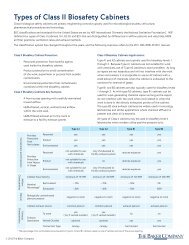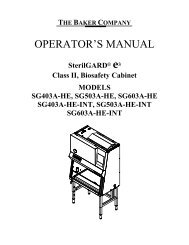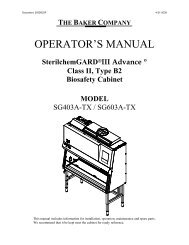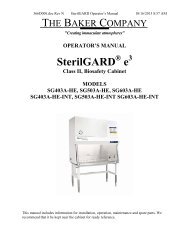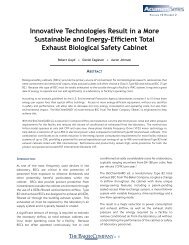Ergonomic Considerations In The Development Of ... - Baker Company
Ergonomic Considerations In The Development Of ... - Baker Company
Ergonomic Considerations In The Development Of ... - Baker Company
You also want an ePaper? Increase the reach of your titles
YUMPU automatically turns print PDFs into web optimized ePapers that Google loves.
Poor posture and positioning were the most commonproblem observed. Work at the biosafety cabinetsrequired researchers to hold their heads and arms in aforward position with shoulders rounded forward. Sucha static posture can compromise the vascular supply,compress nerves in the arms and increase muscle stressand strain. This hunched-forward position, compromisingthe ideal "double S" curve of the spine, is furtherexaggerated when the feet are placed on the ring-stylefootrest common to many lab stools. Proper posture isthe "neutral" position, or the position that requires theleast amount of muscle force and allows maximum roomfor blood flow. This proper posture should be: ears overshoulders, shoulders in line with hips, forearms 90degrees or more from the upper arms and wrists in neutralposition. 4Immunex found that the use of an industrial-heightfootstool allows technicians to achieve the best possibleposture and position at the static biological safety cabinet.<strong>The</strong> footstool allows the user to plant his feet firmlyin front to give a solid, three-point base of support.Providing an adjustable lab stool with enhanced lumbarsupport was also an important improvement. This styleof lab stool provides employees working in a forwardposition (such as at a biosafety cabinet) with needed supportduring rest periods. 5THE BAKER DESIGN PREMISEConscious of problems in the laboratory, the <strong>Baker</strong><strong>Company</strong> design team conducted its own research whendeveloping the SterilGARD® III Advance°, surveyinglab workers and ergonomics experts including WilliamH. Moore, Ph.D., Professor of <strong>Ergonomic</strong>s, Universityof Southern Maine. <strong>The</strong> team also utilizedMannequin, ergonomic design software allowingthree-dimensional modeling of the human body in relationto design criteria input into the program. Throughthe collection of this data, the team was able to determinethe ideal settings for workers seated or standing ata biological safety cabinet.During their research, the <strong>Baker</strong> <strong>Company</strong> teamobserved many of the same risk factors which appearedin the labs at Immunex. <strong>The</strong> team wrote design criteriafor the new SterilGARD® III Advance° to address thoseproblems:• <strong>The</strong> distance between the front of the cabinet andthe front of the solid work surface is minimized toallow the worker to position himself/herself close tothe cabinet’s work tray and to operate in the natural8-14" reach range.• <strong>The</strong> viewscreen slope is 10° forward of vertical toallow a natural, "neutral" head-over-shouldersposition and also minimizes light reflection andglare.• Switches, alarms and gauges are at eye level whenan investigator is standing in front of the cabinet toallow ease in operation.• Petcocks, electrical outlets and other services insidethe work area are positioned toward the front toreduce lab personnel’s need to reach and stretchrepetitively out of the head-over-shoulders position.• An infinitely adjustable bench permits a range ofwork surface heights from 27 3/4" to 39 1/2",allowing adjustability for worker comfort.• An optional adjustable footrest allows lab personnelto establish comfortable positioning beneath thecabinet.• An optional armrest provides a large radius surfacearea on which forearms may rest, eliminating pinchpoint areas and nerve impingement.• Depth of drain pain is reduced. 6ELEMENTS BEHIND ERGONOMICSFailure to outfit and setup a laboratory workstationproperly can encourage the development of RSIs. <strong>The</strong>proper chair adjusted to the correct setting and tablesand work surfaces set at a comfortable height canimprove worker comfort and productivity. <strong>In</strong> addition,attention to environmental and user/equipment interfacefactors will create the most ideal "ergonomic" worksituation.CHAIRA worker who is seated for prolonged periods requiresboth support and adjustability from his or her chair.While traditional office chairs were quite static, newerchairs are dynamic in their movement and adjustability.Even so, workers who have access to these chairs rarelyknow how to adjust them properly for the ideal workposition. 7 As seen in <strong>Baker</strong>’s research, when a worker isnot seated properly at the cabinet or work station, anumber of conditions can occur:• When the chin is dropped or raised, muscles haveto work harder to support the head; compensatingfor a too high or too low head position puts strainon neck and back muscles.• When a worker never makes contact with the chairback, the trunk works harder to balance the body.<strong>The</strong> pelvis is rotated backward and the lower curveof the spine is rounded out, causing a slump. <strong>The</strong>spine is not able to do its structural work and isrotated out of the ideal double "S" curve.• If the feet are not in contact with a firm surface, thelegs become a load on the spine or the worker willstretch his or her ankles and legs to make contactwith the floor.• If the seat pan of the chair is tilted too far forward,the legs do more work to push the body back intothe chair.• If the seat pan is tilted too far back, the knees arepositioned over the thighs, rotating the pelvis backand rounding out the spine. This reduces structuralcapacity of the spine.• Ideally, thighs should be horizontal and parallel tothe floor. 8When establishing an ergonomic workstation, attentionshould be given to selecting the proper chair.• A chair should have at least five legs for stability ifon casters.• Casters must allow for easy movement when seated.• Seat height should be pneumatically adjustablewhile seated.• Seat width of 17-20" suffices for most people andshould be deep enough to permit the back tocontact the lumbar backrest without impingingnerves in the backs of knees.• <strong>The</strong> front edge should be padded and contouredinto a waterfall design behind the knees.• <strong>The</strong> seat slant should be adjustable (0 to 10°).• <strong>The</strong> seat should swivel easily. 92






